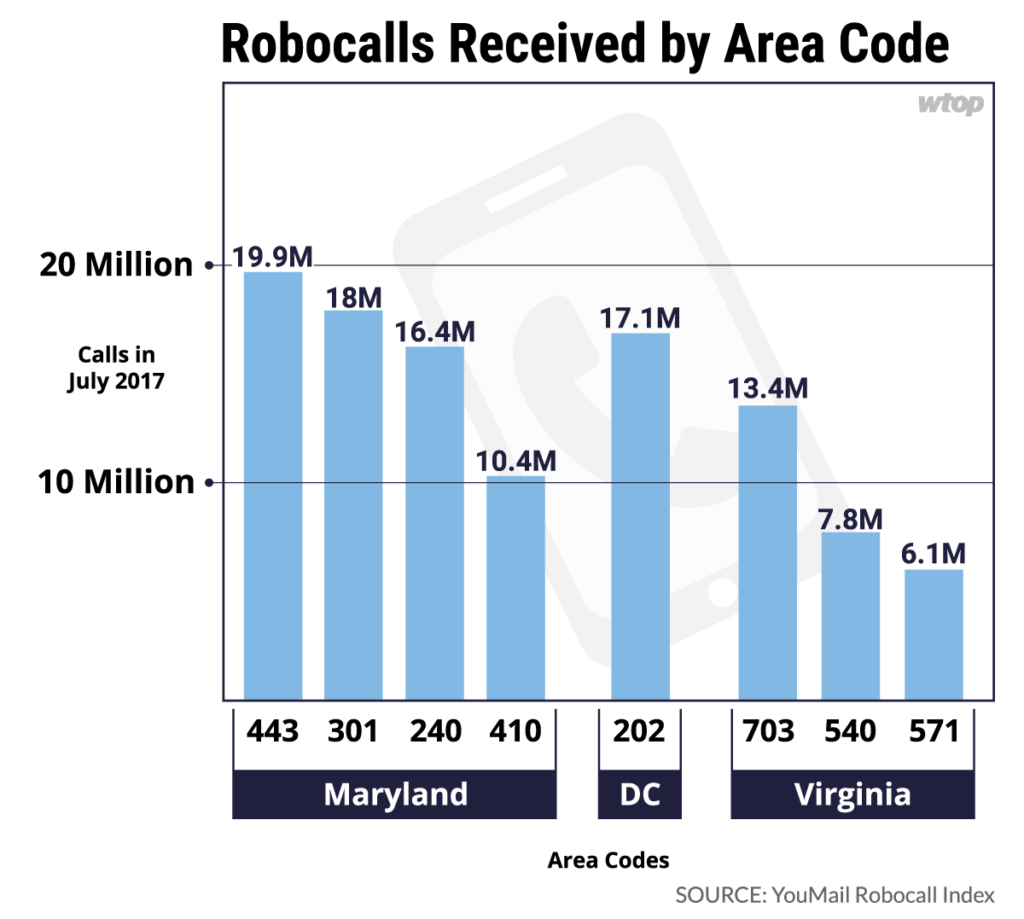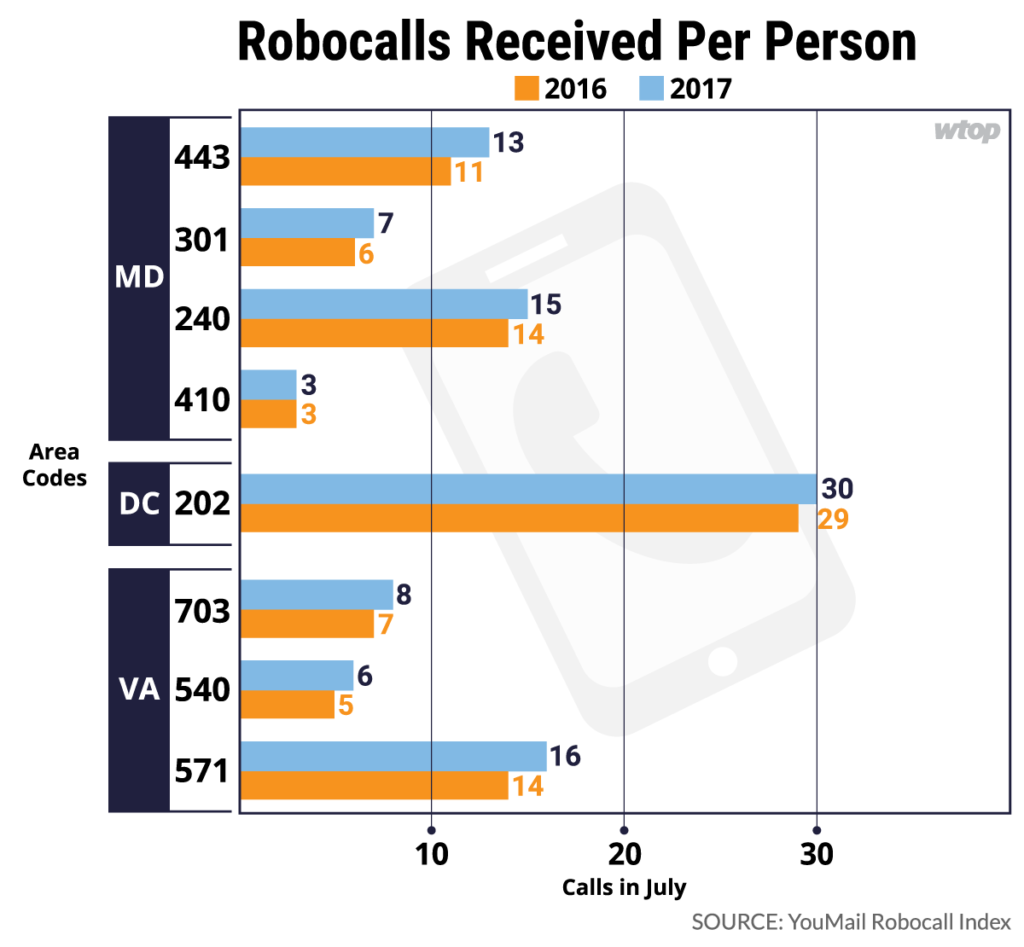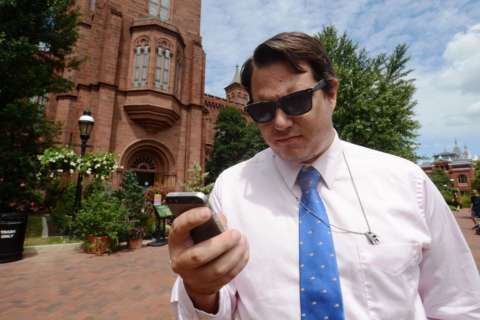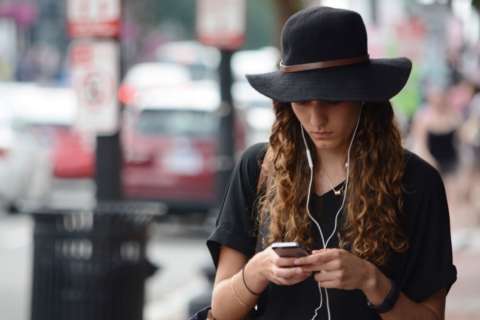This is Part 1 of “Robo Rage,” WTOP’s series on robocalls and their impact on the D.C. area. Read Part 2. Read Part 3.
WASHINGTON — Robocalls annoy just about everyone, but the D.C. area is targeted by computer-generated calls more than other parts of the country. Some in the region even get more robocalls than their neighbors, depending on their area code.
Consumers nationwide received 2.3 billion robocalls every month on average, according to the Federal Communications Commission. If every American could answer the phone, including infants, that’s about eight calls per person.
“Consumers are getting bombarded more than ever before. … We’re committed to trying to stop the flood, but it’s a flood right now,” Federal Communications Commission Chair Ajit Pai told WTOP.
Robocalls are the No. 1 consumer complaint to the Federal Trade Commission, up 60 percent in 2016 from the year before, according to the FTC Do Not Call Data Book.
Targeting the DC area
In the last six months, FTC data showed that most complaints in the D.C. region came from area code 703. Phones in the D.C. area ring more often with robocalls than those in other parts of the country.

“I would have expected the 202 to be pretty low. But it’s not. It’s like 17 or 18 calls per person per month on average,” said Alex Quilici, CEO of YouMail, a consumer call-blocking service that tracks robocalls nationally.
“So in Seattle, it’s two or three per person. The Bay Area average is two or three per person a month,” Quilici said, to provide comparison.
Robocalls are differentiated from live telemarketing calls because there isn’t a real person on the other end of the line, though they are often designed to sound like a person to get a response, according to Mitch Katz, who oversees communications related to telemarketing for the Federal Trade Commission. Robocalls have been illegal in the U.S. since September 2009.
“The Robocall Task Force is an industry-led group looking for solutions to the problem. And one of the suggestions the task force came up with last year was for the FCC to allow carriers to block calls that are spoofed,” said Pai.
“Spoofing” is the practice of disguising an originating phone number from caller ID.
Some robocalls are legal under U.S. communications law, including those that consumers opt in to receive, such as calls from their child’s school, their pharmacy, political or charity calls.
Robocalls to local area codes
 YouMail’s Robocall Index estimates that consumers with the D.C. area code 202 got 30 robocalls per person in July 2017. Area codes 301 and 703 received about seven calls per person in the same month. Outside the city, the area codes hit the hardest are 571 and 240, where in just the month of July, consumers received at least 15 robocalls.
YouMail’s Robocall Index estimates that consumers with the D.C. area code 202 got 30 robocalls per person in July 2017. Area codes 301 and 703 received about seven calls per person in the same month. Outside the city, the area codes hit the hardest are 571 and 240, where in just the month of July, consumers received at least 15 robocalls.
Some consumers might notice they’ve been getting more robocalls, which could indicate their phone number was flagged as a “good number,” meaning the robocallers know there’s a person who answers the phone.
“So if it ever asks you to press 9 to get off the list, don’t. Because pressing 9 will put you on the list. … Just the mere fact you answer will put you on the list. That’s why it’s so important not to answer these calls and to have services that try to fool robocallers,” Quilici said.
Quilici advises consumers to let unknown numbers roll to voicemail, use call-screening services and remain skeptical.
“It’s good to be paranoid now,” Quilici said. “There’s a really good chance it’s a scammer calling you. We see, sometimes it’s up to 50 percent of the calls coming in are scams.”








